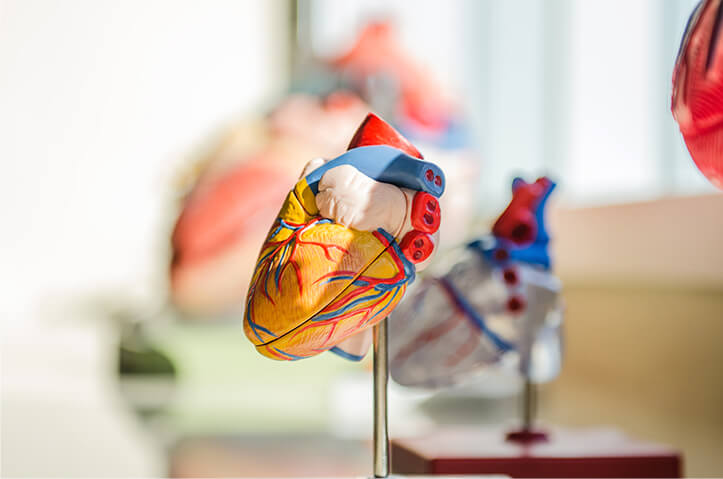
Afib causes and risk factors
Last update: January 18, 2024
Various atrial fibrillation risk factors
Little is known about the exact causes of atrial fibrillation however several factors can increase the likelihood of triggering atrial fibrillation, such as stress. Did you know that atrial fibrillation mainly occurs in Western countries? It’s believed that your lifestyle can have a major influence. We briefly explain the main causes of atrial fibrillation.
Common afib risk factors:
- Aging
- Lifestyle (diabetes, obesity, and blood pressure can have an influence)
- Stress
- Heredity
- Congenital heart valve defects
- High-intensity exercise
In addition to the factors listed above, several other external factors, including self reported factors , negatively influence the risk of developing atrial fibrillation. Among these are, for example, alcohol consumption, anemia, drugs, medicines, and caffeine uptake.
Aging and atrial fibrillation
Atrial fibrillation is more often observed in elderly people. Mechanistic studies found that cell damage may play a role in atrial fibrillation due to aging, but how exactly is this linked? Every cell in your body contains proteins that ensure that the cell works properly. As you get older, the protein’s ability to function decreases. This means that cell function also decreases. This process also happens in the atrial heart cells and leads to cell deterioration, which can cause atrial fibrillation. Moreover, atrial fibrillation accelerated aging of atrial heart cells. In this way aging has been linked to a higher incidence of atrial fibrillation.
Lifestyle may cause afib
Atrial fibrillation is much more common in Western countries than in the African continent or rural China. This shows that our lifestyle plays an important role. Epidemiological research shows that there are an increasing amount of people with diabetes, obesity, and a sedentary lifestyle which have been linked to an increased risk of atrial fibrillation. It may therefore be a wise decision to adjust your lifestyle to reduce the risk of atrial fibrillation.
Stress reported as one of the most common afib triggers
Many patients indicate that stress plays a major role in atrial fibrillation. Although little research has been done on stress-prevention in atrial fibrillation. Long-term stress seems to have a negative influence. Learn what you can do to recognize stress and to reduce stress.
Congenital Heart Disease, Valve Defects and atrial fibrillation
The most common heart defects that can trigger atrial fibrillation are:
- Atrial septal defect
- Bicuspid aortic valve
- Tetralogy of Fallot
Atrial fibrillation may occur in some patients with a congenital heart disease (estimated 5%), which is termed congenital atrial fibrillation. Congenital atrial fibrillation results from a combination of embryogenesis defects (which themselves might be partially due to genetic mutations) and peri-operative and post-operative factors related to surgical treatment for their heart disease. Patients with congenital atrial fibrillation develop the arrhythmia at a younger age, compared to ‘wear and tear’ atrial fibrillation, and often progresses rapidly from paroxysmal to persistent and permanent atrial fibrillation.
Heredity and atrial fibrillation
In approximately 15% of atrial fibrillation patients, there is no discernable reason for the defect. They are young, have no risky lifestyle factors, and have no congenital heart defects. In this case, it often means that the rhythm disorder is a hereditary variant of atrial fibrillation. Existing research has found that there are certain gene sequences that have been associated as risk factors for atrial fibrillation and that approximately 22% of atrial fibrillation cases in the European population can be linked to a gene mutation.
Questions that the AFIP foundation are investigating are: which gene variants are known and what is the status of research into familial atrial fibrillation?
Intense exercise
Exercise is very important in maintaining good physical fitness and an active lifestyle has been linked to many positive outcomes for cardiac health. However, intense exercise can actually have the opposite effect. Long-term intense exercise enlarges your heart muscle, causing small adjustments in the structure of the atrial heart cells. These can disrupt the electrical signaling and can lead to atrial fibrillation. This has been seen especially in athletes who do intensive running, cycling, or rowing.
References
- Brundel, B.J.J.M., Ai, X., True Hills, M., Kuipers M., Lip G.Y.H., De Groot N.M.S. (2022). Atrial fibrillation. Nat Rev Dis Primers 8, 21. https://doi.org/10.1038/s41572-022-00347-9
- Chung, M. K., Eckhardt, L. L., Chen, L. Y., Ahmed, H. M., Gopinathannair, R., Joglar, J. A., … & Biology, V. (2020). Lifestyle and risk factor modification for reduction of atrial fibrillation: a scientific statement from the american heart association. Circulation, 141(16). https://doi.org/10.1161/cir.0000000000000748
- Newman, W. P., Parry-Williams, G., Wiles, J., Edwards, J., Hulbert, S., Kipourou, K., … & O’Driscoll, J. M. (2021). Risk of atrial fibrillation in athletes: a systematic review and meta-analysis. British Journal of Sports Medicine, 55(21), 1233-1238. https://doi.org/10.1136/bjsports-2021-103994
- Nesheiwat, Z., Goyal, A., & Jagtap, M. (2023). Atrial Fibrillation. In StatPearls. StatPearls Publishing. https://www.ncbi.nlm.nih.gov/books/NBK526072/
- Wasmer, K., Eckardt, L., & Breithardt, G. (2017). Predisposing factors for atrial fibrillation in the elderly. Journal of geriatric cardiology : JGC, 14(3), 179–184. https://doi.org/10.11909/j.issn.1671-5411.2017.03.010
- Roselli, C., Rienstra, M., & Ellinor, P. T. (2020). Genetics of atrial fibrillation in 2020. Circulation Research, 127(1), 21-33. https://doi.org/10.1161/circresaha.120.316575
- Weng, L. C., Choi, S. H., Klarin, D., Smith, J., Loh, P. R., Chaffin, M., … & Lubitz, S. A. (2017). Heritability of atrial fibrillation. Circulation: Cardiovascular Genetics, 10(6). https://doi.org/10.1161/circgenetics.117.001838
Share this article
















